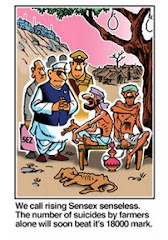
US stocks declined Friday but held on to solid gains for the week, as investors wondered how badly the economy is ailing, and when it is going to recover.
The Dow Jones Industrial Average remained volatile Friday, swinging in a 563-point range including big gains and losses. A late-day swoon left the blue-chip measure down 127.04 points at the closing bell, off 1.4%, at 8852.22. Caterpillar was the Dow's weakest component on Friday, off 7.2% following a round of downbeat housing data. The average's financial names all finished lower as well, hurt by lingering worries about the credit crunch. Citigroup was the weakest of that group, off 6.4%.
But for the week, the Dow rose 4.8%, its first such gain since the meltdown of Lehman Brothers Holdings set off a global financial crisis in mid-September. The gain was also the Dow's biggest weekly rise in percentage terms since March 2003.
Although the global economy's weakness remains deep-seated for now, the timing of a potential turnaround also remains a hot topic of debate on Wall Street, with some investors placing early bets on a rebound both in the U.S. and overseas.
"Based on what we're seeing, the second half of this year is shaping up to be really, really bad," said Deutsche Bank economist Joe LaVorgna. "But it could also be so bad that it wipes out any remaining imbalances. What you'll be left with is a lot of pent-up demand."
Pump prices have generally been on the decline lately, but other pressures remain for consumers whose buying activity represents more than two-thirds of the overall U.S. economy. Employment has fallen for nine straight months, the struggles of major financial institutions have made it more difficult to get credit, and lower home prices have cut into the wealth of many families.
On Friday, the Commerce Department reported that construction of new dwellings dropped 6.3% last month to the slowest pace since January 1991, when the U.S. was in the midst of an eight-month recession and going through another painful housing correction.
However, that recession was brief by historical standards, unlike the scenario worrying some investors and analysts who say the current slump could last several years. Mr. LaVorgna said he believes those fears are overblown, with a recovery possible perhaps in the second quarter of 2009.
Similar sentiments were evident in a column in Friday's New York Times by renowned investor Warren Buffett, who recommended buying U.S. stocks. The billionaire said that his entire personal fortune may soon be invested in the domestic market in anticipation of an economic recovery.
"If you wait for the robins, spring will be over," wrote Mr. Buffett. "Bad news is an investor's best friend. It lets you buy a slice of America's future at a marked-down price."
Other stock measures slipped Friday but finished with weekly gains. The S&P 500 fell 0.6% to 940.55, up 4.6% on the week. The broad measure was hurt Friday by a 2.9% drop in its financial sector, although gains in basic materials and energy, up 2.7% and 2.2% respectively, kept the S&P's daily decline in check.
The technology-oriented Nasdaq Composite Index was down 0.4% for the day, ending at 1711.29, up 3.7% on the week. The small-stock Russell 2000 tumbled 1.9% to 526.43, up 0.8% on the week.
More instability is expected in the market in the weeks ahead. The Chicago Board Options Exchange's Volatility Index, which uses options prices to measure investors' nervousness about upcoming stock-market swings, was up about 4%, ending at 70.33.
Options contracts on individual stocks and major indexes expired on Friday, which added wider-than-normal swings in the market. Traders must buy or sell shares to offset their expiring options bets.
The credit markets showed further signs of easing, although traders and analysts warned that conditions could remain stop-and-go awhile longer. The British Bankers Association quoted Libor -- a key interbank lending rate -- at 4.41875% for three-month loans of U.S. dollars, down from Thursday's fixing of 4.5025%. The one-month rate fell to 4.18125% from 4.2775%.
But those rates are still well above the levels seen before the failure of Lehman Brothers and before the Federal Reserve and its overseas colleagues carried out their coordinated rate cuts.











